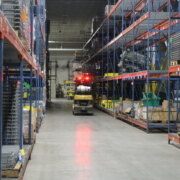Safety is a critical part of any facility and some consider it one of the most important aspects that a company should focus on. June is National Safety Month, and to recognize it, we created a summary of warehouse safety tips that no facility should be without.
Want to learn more about our safety tips? Click here to download our full warehouse safety checklist!
EMPLOYEE SAFETY
Employees are the greatest asset to any facility, in order to protect that asset, it is imperative to abide by safety protocol. Employees should fully understand dress code and, if not, ask their manager to be clear.
Personal Protective Equipment (PPE) should be readily available to the worker, depending on the type of work being done. Safety glasses will protect workers from anything in the air that could potentially harm their eyes. Hardhats are another PPE that are typically worn when there is a risk of debris falling from above, or when working at elevated levels. Closed-toed shoes are almost always a must to be worn so that feet are fully protected. Hardhats, safety vests and safety glasses are just a few PPE’s in the workplace that helps to protect an employee from danger.
EQUIPMENT & MATERIAL
Safe material handling keeps a warehouse running smoothly. You can protect your material with the right safety equipment, (end of aisle guards, guardrail, column protectors, etc.) and by establishing material handling best practices.
It is important to ensure that all employees are properly trained on stacking material on high shelves, platforms or in high stacks. Have them keep heavy objects at the bottom and stacked neatly so items do not shift. Not stacking material correctly may heighten the risk of an accident to occur.
FORKLIFTS
Before every shift, make sure that your forklifts are not only operational, but shielded to keep the driver out of harm’s way from falling material. Operators should also be conscious of their own safety as well as others by making sure to always wear a seat belt, testing the warning systems, keeping a safe distance from other operators and honking when making a turn or approaching an opening.


